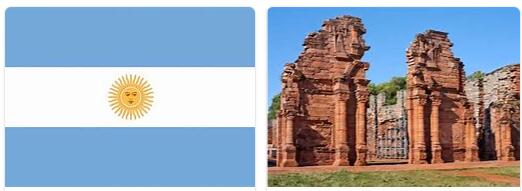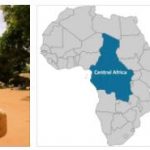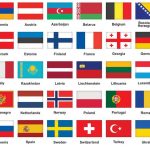History
The numerous Indian tribes that populated the country did not yet have a high culture when the Spanish conquerors invaded Argentina. Argentina was also incorporated into what was then the viceroyalty of Peru, but then tried to free itself from this violent union through its own viceroyalty of Buenos Aires with independent administration. In 1810 the freedom fighters began to revolt against the Spanish colonial rulers. Until the end of the 19th century, there were repeated power struggles between the individual political groups that had formed. As then at the beginning of the 20th century the mass immigration from Europe began, the country experienced a rapid economic upswing, which was suddenly ended by the global economic crisis. With coups d’états and military coups, the most diverse rulers tried in their own way to combat the economic plight of the population. From 1946 to 1955, Colonel JD Perón and his wife Evita tried to consolidate the country through economic and social reforms. In 1955 he too was overthrown in a military coup. Until 1983 the political situation changed constantly, only then was it possible to enforce democratic elections again. Today Argentina is a presidential democracy that tries to do justice to the numerous interests of its residents of various origins. Visit thedresswizard.com for history of south America.
Business
Argentina is an agricultural state despite the increasing number of industrial companies (iron and steel, textiles, energy)remained. Large parts of the country are used for agriculture and animal husbandry. At 57%, the most important commercial products are foods such as beef, dairy products, pome fruit and wine. The export of fuels and energy has remained almost constant at 11%. A new branch of industry developed through the establishment of biodiesel production facilities. The automotive industry has also become an important branch of industry, with Brazil being the main export country. Further exports of various kinds go to the other South American neighboring countries, to Asia, to the EU and to the North American free trade area. Like every other country in the world, Argentina has been hit by the economic crisis, but not to a worrying extent.
Memberships
Argentina is one of the founding states of the United Nations (UNO), is a member of the World Trade Organization (WTO) and of the Mercado del Sur (MERCOSUR).
Population
Today only a few descendants are left of the local population, various Indian tribes such as Quetschua, Guaraní and Pampa Indians. Only 2% of the roughly 40 million residents can boast of being of indigenous descent. Today they live in the Chaco, in inaccessible Andean valleys, in Patagonia and on Tierra del Fuego. Around one million people are of German origin or German citizens who live primarily in central Argentina. Other citizens come from Italy and Spain. This means that over 95% of Argentines are of European origin.
On December 17, 1939, the crew of the armored ship Graf Spee sank their ship in the bay of the Río de la Plata. The team first went to Buenos Aires and then moved to Villa General Belgrano in the province of Cordoba. The houses in German architectural style are still part of the picture of this small town with approx. 5,000 residents.
Tango
The Argentine tango, or more precisely “Tango from the Rio de la Plata”, was declared a World Heritage Site in September 2009.
Tango originated from a mixture of musical styles from various immigrant groups, such as Africans, Germans, Austrians, Spaniards and Italians, but also from other South American countries. The Germans brought the bandonion with them, a kind of harmonica that developed into the most typical tango instrument. The twists and turns of the waltz and the landlord were also incorporated into the step elements of the dance. Most of the rhythm comes from the music of the Africans. Originally, the tango was danced by the poorest class, who attended large dance events, milongas, for this purpose, met. Shortly before the First World War, the tango came to Paris and became socially acceptable. It became one of the great dance styles in the world that was taught in all dance schools. Dance competitions also became more and more important and the winners were able to set up their own salons and even dance schools. In times of economic crisis, the tango became an economic engine. Today the tango is danced in many styles or sung with socially critical texts. It has remained alive and musicians of all generations have adapted it to new musical styles again and again and saved it from extinction.
Language
In Argentina, the national language is Spanish. In some regions, such as in parts of the greater Buenos Aires area and in the province of Córdoba, German is still sometimes spoken today.
Religion
90% of the population are Roman Catholic, the remaining 10% are divided between the Protestant, Islamic and Jewish faith.
Food and drink
The Argentine breakfast is very similar to the European one. Toast, croissants, bread with butter and “ dulce de leche ” (caramel spread) and a coffee with milk or tea are usually typical.
Argentine meat is world-famous for its excellent quality. It is the main component of the Argentine diet and should not be missing from a really good meal.
Empanadas are very typical of Argentina and are available almost on every corner. These are filled dumplings that are made of a kind of puff pastry and are filled in a very varied way. The filling with meat, chicken, cheese and ham, cheese and onions, spinach, corn porridge or tuna is typical.
The Argentines prefer to drink red and white wine as well as beer. You can also buy mineral water, lemonades and juices everywhere, and milkshakes are also very popular. You don’t have to go without your coffee here either. As a national drink, but one actually a special type of tea: the mate tea. Due to its complex preparation and way of drinking it is rarely offered in restaurants and cafes, if you find it here in tea bags, however, you are often invited to this “friendship ritual” during your stay in Argentina.
Money / currency
You can exchange euros at banks and exchange offices, but the US dollar is also gladly accepted. In addition, you can pay with a credit card in larger cities or withdraw money from the machines.
Current
The voltage is in Argentina as in Germany 220 volts. An international adapter enables the use of our technical devices.
Medical advice
You can get the latest information from your family doctor or the website of the Center for Travel Medicine (CRM).
Security / drugs
Argentina is very safe compared to other South American countries. However, in order to avoid problems with the Argentine authorities, contact with drugs should definitely be avoided. You should also be careful with handbags, etc., in metropolitan areas, as is the case everywhere.
Current information on the security situation in the country can be found at https://www.auswaertiges-amt.de/.
Entry
To enter Argentina, travelers need a passport that is valid for at least 6 months. No visa is required for stays of less than 90 days. During the flight you usually receive a tourist card, which you have to carry with you at all times. Upon arrival at the airport, travelers’ fingerprints are scanned and portraits are taken.
Addresses
In Germany:
Embassy of the Republic of Argentina
10787 Berlin
[email protected]
There are consulates general in Frankfurt am Main, Hamburg and Bonn
The addresses of all consulates are listed at the Federal Foreign Office.
In Argentina
Embassy of the FRG
Calle Villanueva 1055, C1426BMC
Buenos Aires
Other honorary consulates in
Cordoba, Eldorado, Mendoza, Posadas, Salta, San Carlos de Bariloche, San Miguel de Tucumán, Santa Fé, Ushuaia
Ministry of Foreign Affairs
In Germany https://www.auswaertiges-amt.de/
In Austria https://www.bmaa.gv.at/
In Switzerland https://www.eda.admin.ch/
Frequently asked questions about Argentina
What are the entry requirements for Argentina?
Since May 2012, new regulations apply to entry into Argentina. The fingerprints of every traveler are digitally scanned at the airport / seaport and a digital portrait photo is created. German citizens can enter Argentina as tourists for up to 90 days without a visa. To enter the country, you need a passport, which must be valid for three months upon arrival.
What vaccinations do you need to travel to Argentina?
No vaccinations are required for Argentina. It is recommended to be vaccinated against hepatitis A and, in the case of long-term stays of four weeks or particular exposure, also against hepatitis B, yellow fever, rabies and typhoid. We urgently recommend taking out health insurance abroad, which should include repatriation.








